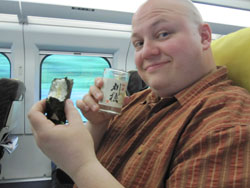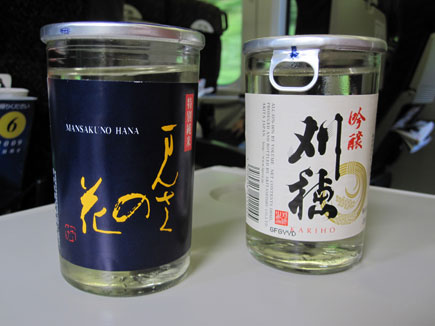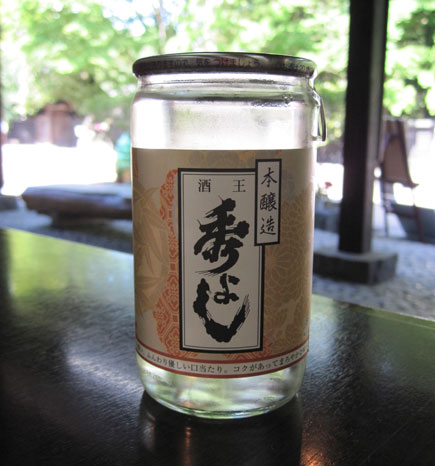Cup Sake Guest Post: Todd Bellomy

One Cup Sake Fan Todd Bellomy
Todd has always been so generous with his sake knowledge, it was no surprise to me when he enthusiastically accepted my offer to provide a guest post for UrbanSake.com “One Cup Sake” week. Todd also gives us some great photos and his picks for some of the best Akita Cup sake out there! Take it away, Todd…
Not all cups are created equal
Cup sake is becoming popular in US, so it is time for a clarification of vocabulary. “Cup Sake†and “One Cup†are different things. “Cup Sake†is a term for any sake sold in a cup container and sealed with a vinyl-coated metal lid. “One Cup†is a futsu-shu sake made by Ozeki Breweries and was one of the first cup sake available. With either kind, the peel-off lid just needs to be removed to uncover the full glass of sake underneath.
Cup sake selection seems to be increasing in Japan as well, with more cup sake varieties available now than just a few years ago. Sake consumption in Japan is falling; last year sake only accounted for 8% of the overall alcohol consumption there. It may be to combat this severe decline that Japanese breweries are offering more sake in this convenient package.
The selection of cup sake in Japan’s big cities used to be limited to sake from the mega-breweries. However, if you traveled to the more rural areas of Japan, you could find higher quality, locally made sake sold as cup sake. Now in the big cities, especially in Tokyo, there is an influx of jizake cup sake, creating not only an increase in variety, but also a boom in quality.
I noticed while in Japan last month that cup sake displays were everywhere. The displays were not only in the usual places like convenience stores, train stations and vending machines. I noticed that there were new shelves of cup sake in liquor stores, increased cup sake displays in supermarkets, and more cup sake for sale brewery tasting rooms. This convenient package is being heavily marketed in Japan this summer.
My favorite thing about cup sake in Japan is the fun and enjoyment of a delicious cup of Junmai Daiginjo that can be consumed anywhere. This is possible in Japan because there is no stigma connected to – or laws against – public drinking: you can enjoy sake or a beer on the train, in a park, or many other public areas. In the US, one barrier to distribution of high-quality cup sake is the lack of need for portable, convenient sake. Where would you be able drink it? Another reason for the scarcity of cup sake in the US is the American tendency to form preconceptions about quality based on packaging. We do this with beer in a can, even though there is now great craft beer available in cans, and with screw-top wine, even though the rest of the world now accepts screw-tops as a modern, quality preserving device.
Although it won’t happen overnight, my hope is that Americans will stop judging a drink by its container. Maybe accepting variety in packaging is a crucial first step to shedding our puritanical heritage and allowing responsible public drinking. After all, after a long day of working or traveling, opening a perfectly hand-crafted cup sake on the train is just so… civilized.
Mansaku no Hana Tokubetsu Junmai & Kariho Ginjo

Mansaku no Hana Tokubetsu Junmai (above left)
Slightly lower alcohol lends a softness to this Akita sake. Soft, honey like nose with touches of flowers and rice. Clean, pear/apple notes on mid palette with a crisp, short tail of rice and alcohol
Kariho Ginjo (above right)
Not as delicate as their junmai ginjo; this ginjo cup sake delivers of restrained rice and soft fruit esters. In balance with the rice and fruit is a layer of yamahai like fermentation notes that adds some beefiness to this cup!
Hideyoshi Honjozo

Hideyoshi Honjozo, Akita-ken
This honjozo sang with heavier akita rice flavors, paired with some surprisingly complex apple blossom and nectar flavors. We had this cup with some Kiritampo – akita rice formed on sticks and charcoal grilled with sweet miso glaze. Awesome mid day snack!


